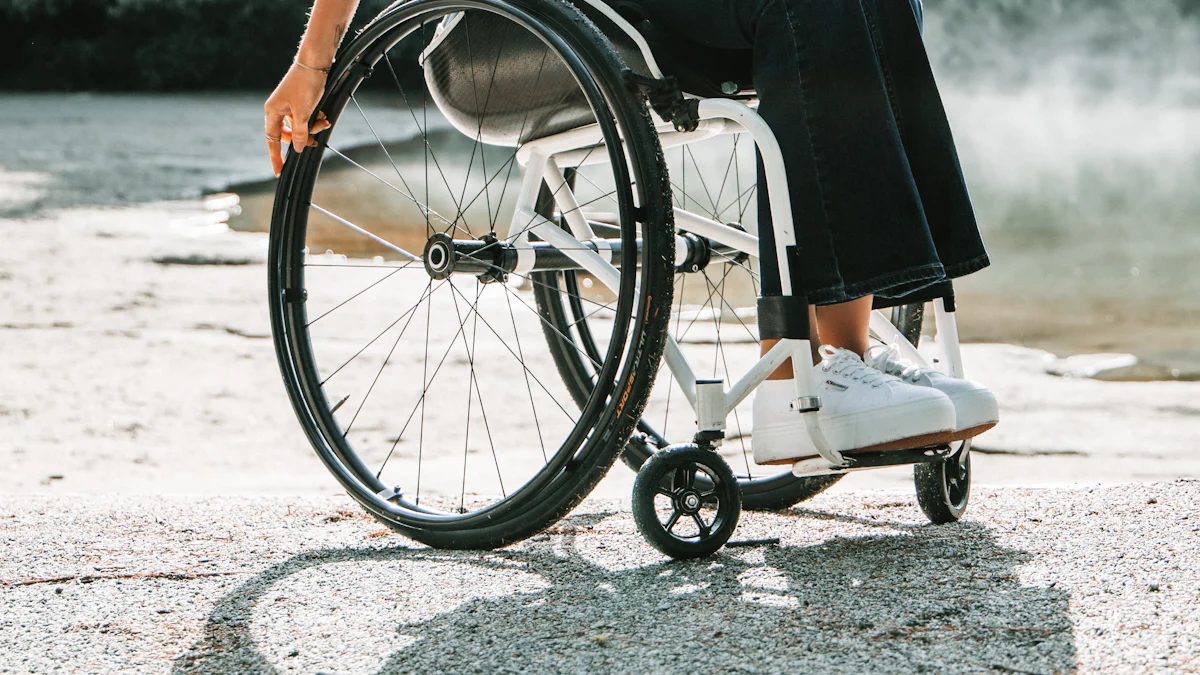ADA compliance ensures accessibility for all individuals. Businesses that prioritize accessibility often outperform competitors. A wheelchair ramp plays a crucial role in enhancing accessibility. Many businesses face lawsuits due to non-compliance with ADA standards. Adhering to these standards can prevent legal issues and offer tax benefits. Small businesses can receive up to $15,000 per year in tax deductions for accessibility improvements. Embracing ADA compliance not only fulfills legal obligations but also promotes inclusivity and equality.
Overview of ADA Requirements
Key ADA Guidelines for Wheelchair Ramps
Slope and Rise Specifications
The Americans with Disabilities Act (ADA) sets specific guidelines for the construction of wheelchair ramps. These guidelines ensure safety and accessibility for individuals with disabilities. A crucial aspect involves the slope and rise specifications. The ADA mandates a maximum running slope of 1:12. This means that for every inch of elevation change, the ramp must extend horizontally by at least one foot. The maximum rise for any single ramp run is 30 inches. This specification ensures that users can navigate the ramp safely without excessive effort.
Width and Surface Requirements
Width and surface requirements also play a vital role in ADA compliance. The clear width of a wheelchair ramp must be at least 36 inches between the handrails. This width accommodates various mobility devices, ensuring ease of use. The surface of the ramp must be stable, slip-resistant, and firm. These characteristics prevent accidents and provide a secure path for users. Level landings are required at both the top and bottom of each ramp. Each landing must have a minimum length of 60 inches. These landings offer users a safe space to rest or turn.
Importance of Compliance
Legal Implications
Compliance with ADA guidelines holds significant legal implications. Non-compliance can lead to lawsuits and penalties. Businesses must adhere to these standards to avoid legal issues. The ADA guidelines serve as a benchmark for accessibility in public and commercial spaces. Following these guidelines demonstrates a commitment to inclusivity and equality.
Benefits for Businesses and Individuals
Adhering to ADA requirements offers numerous benefits for businesses and individuals. Businesses that comply with these standards enhance their reputation. Accessibility improvements attract a broader customer base. Many customers appreciate businesses that prioritize inclusivity. Individuals with disabilities gain easier access to facilities. This access promotes independence and participation in community activities. Compliance also provides financial incentives. Small businesses can receive tax deductions for making accessibility improvements. These deductions encourage businesses to invest in ADA-compliant wheelchair ramps.
Designing Wheelchair Ramps

Essential Design Considerations
Location and Space Planning
Location plays a crucial role in designing a wheelchair ramp. You must select a site that provides easy access to the building entrance. Ensure the path leading to the ramp is clear and unobstructed. Consider the surrounding environment when planning the space. Adequate space allows for a smooth transition from the ground to the ramp. The design should accommodate all users, including those using mobility devices.
Material Selection
Material selection impacts the durability and safety of a wheelchair ramp. Choose materials that withstand weather conditions and heavy use. Wood, concrete, and metal are common choices. Each material offers unique benefits and challenges. Wood provides a natural look but requires regular maintenance. Concrete offers durability but may need a slip-resistant surface. Metal ramps provide strength and require minimal upkeep. Evaluate the pros and cons of each material before making a decision.
Common Design Mistakes to Avoid
Incorrect Slope Ratios
Incorrect slope ratios can compromise the safety of a wheelchair ramp. The ADA specifies a maximum running slope of 1:12. This ratio ensures users can navigate the ramp without excessive effort. A steeper slope increases the risk of accidents and injuries. Always adhere to the recommended slope ratio during construction. Regular checks ensure the ramp maintains the correct slope over time.
Insufficient Landing Areas
Landing areas provide essential resting spots on a wheelchair ramp. The ADA requires level landings at the top and bottom of each ramp. Each landing must measure at least 60 inches in length. Insufficient landing areas create challenges for users. Ensure landings offer enough space for turning and resting. Properly designed landings enhance the overall accessibility of the ramp.
Implementing ADA-Compliant Ramps

Steps to Ensure Compliance
Conducting an Accessibility Audit
Conducting an accessibility audit serves as a crucial first step in implementing an ADA-compliant wheelchair ramp. An audit evaluates the current state of accessibility in your facility. Identify areas that require improvement. The audit process involves assessing the slope, width, and surface of existing ramps. Ensure compliance with ADA guidelines. Businesses must prioritize equal access for all individuals. A thorough audit helps identify potential barriers to accessibility. Address these barriers to enhance inclusivity.
Hiring Qualified Contractors
Hiring qualified contractors ensures the successful implementation of ADA-compliant wheelchair ramps. Contractors possess the expertise needed to design and construct ramps that meet ADA standards. Choose contractors with experience in accessibility projects. Verify their credentials and previous work. A skilled contractor understands the importance of proper slope ratios and landing areas. Collaborate with contractors to develop a ramp design that suits your facility’s needs. Proper installation prevents future compliance issues and enhances safety.
Cost Considerations and Funding Options
Estimating Costs
Estimating costs for constructing a wheelchair ramp involves several factors. Consider materials, labor, and design complexity. Material selection impacts the overall cost. Wood, concrete, and metal have different price points. Labor costs depend on the contractor’s experience and project scope. Design complexity affects the time and resources required for construction. Obtain multiple quotes from contractors to compare costs. Accurate cost estimation helps budget for the project effectively.
Exploring Grants and Financial Assistance
Exploring grants and financial assistance can ease the financial burden of building a wheelchair ramp. Various organizations offer funding for accessibility improvements. Research available grants that support ADA compliance projects. Small businesses may qualify for tax deductions for accessibility enhancements. These incentives encourage investment in inclusive infrastructure. Financial assistance makes it feasible for businesses to prioritize accessibility. Utilize available resources to support the construction of ADA-compliant ramps.
Maintaining and Inspecting Wheelchair Ramps
Regular Maintenance Practices
Cleaning and Surface Care
Regular cleaning ensures the safety and longevity of wheelchair ramps. Dirt and debris can accumulate on the surface, creating slip hazards. Use a broom or leaf blower to remove loose debris. A mild detergent and water solution helps clean the ramp surface. Avoid harsh chemicals that may damage the material. Ensure the surface remains slip-resistant after cleaning. Regular cleaning maintains a safe environment for ramp users.
Checking for Structural Integrity
Inspect the structural integrity of the ramp frequently. Look for any signs of wear, such as cracks or loose bolts. These issues can compromise the safety of the ramp. Tighten any loose bolts immediately. Repair any cracks or damage promptly. Regular checks prevent minor issues from becoming major problems. A structurally sound ramp provides a safe path for users.
Periodic Inspections
Identifying Wear and Tear
Conduct periodic inspections to identify wear and tear. Examine the ramp for any signs of deterioration. Check the handrails for stability and security. Look for any rust or corrosion on metal components. Inspect wooden ramps for rot or splintering. Address any issues found during inspections quickly. Regular inspections ensure the ramp remains in good condition.
Ensuring Ongoing Compliance
Ensure ongoing compliance with ADA guidelines through regular inspections. Verify that the slope and width meet ADA specifications. Check that the surface remains stable and slip-resistant. Confirm that landings provide adequate space for users. Regular inspections help maintain ADA compliance. Compliance ensures accessibility and safety for all users.
ADA compliance for wheelchair ramps holds immense importance. Businesses that prioritize accessibility often outperform competitors. Caroline Casey emphasizes,
“Only by putting staff and customers with disabilities at the heart of business strategies will companies rewrite the cultural narrative necessary to transform how we do business.”
Take actionable steps to ensure compliance. Conduct audits and hire qualified contractors. Prioritize accessibility in your business strategy. Accenture highlights that businesses focusing on disability inclusion grow profits 4.1 times faster. Contact service providers for assistance. Embrace inclusivity and enhance your business’s reputation and growth.









